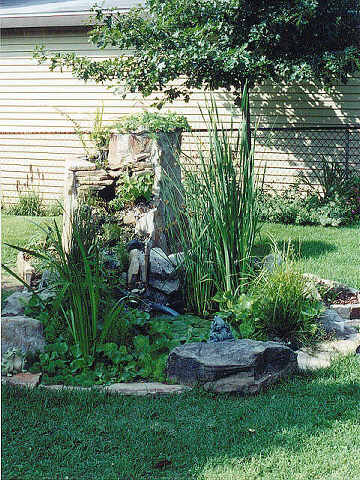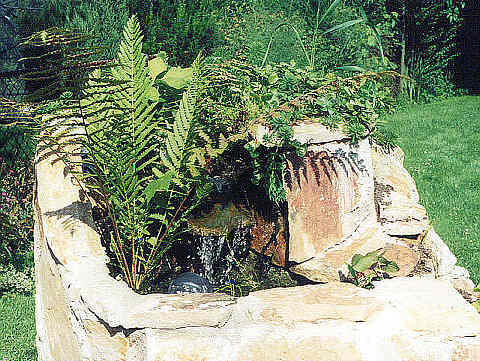|
As
evidenced by the lushness of the fountain's
plantings, thus far, my design seems to be
working. Though I am still learning, (that is one
of the design purposes) most of the plants I have
transferred to the project have adapted well to their
new homes. A few have disappeared from view.
Some to re-sprout, some to fail. But, failure
hasn't happened too often. The individual levels
are quickly taking on unique characteristics, just as I
had hoped they would. Aside from adding makeup
water, the only tasks associated with maintenance of the
fountain are harvesting luxuriant floating water plants
to preserve 10 to 15% open water surface on the pond,
pinching back and harvesting watercress, (Gee what can I
do with that! Yum, Yum!) and weekly fertilizing
with Potassium and Nitrogen rich fertilizer to help
maintain healthy plant growth and control algae.
(An slight excess of Potassium and Nitrogen, relative to
Phosphorus, allows the vascular plants in the system to
"starve" free floating algae of the Phosphorus
it needs to rapidly reproduce.) Most literature
indicates that the presence of fish in the system will
provide adequate nitrogen. However, shortly after
the fountain was stable, the aquatic plants began to
show signs of Nitrogen deficit. I suspect that the
heavy aeration of the water by the series of waterfalls
is driving nitrogen off more quickly than would be the
case in a simple pond. Weekly application of a
very small amount of Nitrogen rich fertilizer has
corrected this problem.
|
|
I chose to utilize biological, rather than simple
mechanical filtration to maintain the water quality of
the fountain. Biological filters utilize natural
nutrient / energy cycles to recycle waste products
into usable nutrients. The filtering agents of
bio-filters are organisms. Aerobic Bacteria
convert urea based nitrogenous animal waste into
soluble nitrates that are a plant nutrient. Anaerobic
Bacteria break down sediment, creating Hydrogen
Sulfide that is released from the system through
aeration. The various plants absorb nutrients
from the water and provide food and shelter for
various organisms, including fish, amphibians, snails,
insects and bacteria. The animals, eating the
plants, produce "waste" that returns
to the cycle. The whole thing is powered by the
sun and an electric pump to circulate the water.
I chose to use ceramic and limestone gravel instead of
commercial plastic filter media, mainly on the basis
of cost, but also because the gravel provides a better
plant growth environment.
If you look closely, (in the top photo), you can see
the intake line, just below center in the
picture. It sucks water from the first stage
biological filter, located at the bottom of the
pond. The pump is hidden inside the tallest
portion of the fountain at pond level. The high
pressure feed line runs up the inside of the
tallest portion of the fountain then out through the
side wall and over the rim of the liner, hidden by
rock facing. The pinch valve is located within
the top level pool. It is set so that
approximately one to two inches of water are lost from
the fountain per day. I usually add makeup water
twice daily, in the morning and evening.
Frequent addition of small amounts of makeup water,
minimizes tap-water chemical contamination by dilution
and allows the heavy aeration of the water falls to
drive off undesirable additives without adversely
effecting either the plants or bacteria working in the
biological filters. I may add a float valve controlled
makeup line in the future. Typically, only
about 1/4 to 1/3 of the available pump flow capacity
is used. Lots of room for expansion!
As shown in the
schematic on the previous
page the top level of the fountain is the second
stage biological filter unit. It contains a deep
bed of ceramic aquarium and limestone gravel.
The gravel provides surface for aerobic bacteria to
grow on. On the surface of the gravel, submerged
soil plants absorb the nutrients released by the
bacteria. I initially planted Parrot's Feather -
Myrophyllum pinnatum and Water Lettuce- Pistia
stratiotes along with the Watercress - Rorippa
nasturtium f aquaticum, just to
fill in the space, but I have been slowly removing
them as the Watercress and other plants begin to take
hold. Also growing in the first level is a shade
loving variety of Sphagnum moss (near the water exit)
with Viola cuculatta and Water Parsnip rooted
in it, as well as an as yet unidentified sedge,
Pinewort, and wetland grasses.
The outflow from the first level is over a rough cantilevered
rock that breaks the stream into curtains of dancing
water droplets as the water drops to the next
level.
|
 |
|
The Enviro-Fountain
|
|


